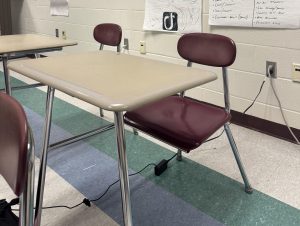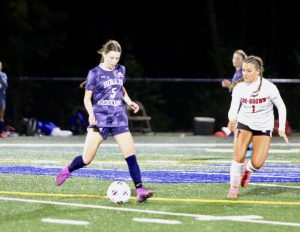Freshmen almost relocated to HBMS

Photo Credit: Evan Moloney
November 10, 2014
Right now, Hollis-Brookline High School holds 832 students.
But if one proposal to deal with the school’s New England Association of Schools and Colleges (NEASC) accreditation had been implemented, more than one in five would be gone.
Over the summer, a core team of administrators met to consider a number of options in dealing with Hollis-Brookline’s need for additional space. After a proposal to build an addition onto the school building was shot down last spring, finding a solution to the school’s overcrowding became a top priority.
Eventually, as students have likely noticed, the decision was made to reallocate a number of resources, classrooms and programs in order to drive efficiency with existing space.
However, this was not the only avenue to be considered, and nowhere near the most drastic.
In a recent interview with the Cavalier Chronicle, culminating with this piece on the reassignment of Room 374 and the Robotics program, Principal Richard Barnes revealed that, before a final decision was made, “there were discussions about moving freshmen down to the middle school.”
The reasoning for this was effectively simple, Barnes said during the first interview. The high school has a lack of space, whereas the middle school has an excess, if classrooms and space are allocated correctly in the smaller building.
However, freshmen would not have been middle-school students for a third year. While they would have been housed in a school shared by the seventh and eighth grades, the building would not have offered an integrated program for all three classes.
“A ten-to-twelve high school was never being considered,” said Barnes. “Freshmen would still be high-schoolers, but they would learn in a different building.”
The Class of 2018 would still have played sports and joined clubs with the high school, had high-school-level teachers and courses. Freshmen would have received the same education with the same resources–but not at HBHS.
“It would be a little strange, and I don’t know what the teacher situation would be like,” said James Surette ‘18. “Basically a third year of middle school, instead of being in actual high school.”
“That would have been shocking, to say the least,” said Maria St. Pierre, the HBHS Wellness teacher. “Every year there’s something new, whether that’s the schedule or the grading program or room changes, and we’re pretty adaptable. I think we’re great that way, as a school. But that would have been a tough one.”
St. Pierre, along with a sizeable minority of HBHS teaching staff, would have been hit hardest with the change. Her classes deal exclusively with freshmen, and relocation for them effectively is relocation for her.
However, the situation would not have been nearly as cut-and-dry for other teachers. While Kate Emerson, also a HBHS teacher, works mostly with freshman Physical Science classes, she also teaches Ecology, a course designed for seniors.
Many other faculty members would have met the same problems, teaching to more than one grade in a day. Heidi Foster teaches English 9, but also AP Literature; Judy McDaniel hosts equal numbers of courses in Algebra 1 and AP Statistics. Elissa Johansson teaches courses in French I, II and IV, and Yolanda Flamino works with both chemistry and physical-science classes.
An even bigger complication was levelled classes–those courses which are inclusive to multiple grade levels, like French, Spanish, mathematics, and many electives with no specific deterrent to freshman students.
Stephen Capraro, a seventh-grade history teacher at HBMS, didn’t take easily to the idea.
“I can’t imagine teachers commuting back and forth–you would have to have dedicated ninth-grade teachers.”
Emerson agreed–while she is wholly “in support of whatever the Administration thinks is going to be best for our kids and their learning”, she wasn’t enthusiastic about the prospect.
“There’s a reason why I teach high school,” she said. “Would it be disappointing for me, to have to leave this building and this culture here to move over to the middle school? Of course it would be disappointing, and it would be a change, but if that’s what we need to support education, then that’s what we have to do.”
The plan stayed within a small inner circle within SAU-41, basically comprised by the Superintendent, his assistant, and key administrative staff at both co-op schools.
However, there was another plan which Capraro, at least, had been aware of. He cited a proposal to split the Freshman class into teams like those at the middle school, which had been dismissed not long after its creation–with the general philosophy: “Who’s going to want to be on that team?” The plan had included moving specific teachers to the middle school, in order to give some benefit to parents willing to retain their children, but it had been shot down even with that condition.
In terms of the complete-relocation plan’s actual feasibility, Barnes cited investigations which had indicated that there was space within the middle school. There is room within the building to teach extra classes–because of the A-Block-B-Block-C-Block schedule in place at the school, there are long stretches of the day wherein other periods are being taught, leaving perhaps a dozen classrooms dedicated to core subjects completely empty.
However, the capacity of the middle school is not dictated just by how much classroom space there is. According to Capraro, the hallway crush found at the high school carries over, even with all the empty classrooms. There is simply no room for “two hundred more bodies”–a figure which, including teachers, would have swelled the school to over 150% of its prior size.
“When I think of the high school, that’s a big building. This is a small building. If we were to just throw two hundred more kids down here, things would be crazy. I can’t imagine that being successful.”
With regard to the freshmen themselves, the overwhelming consensus has been that the relocation would hinder much more than it would help, with NEASC aside. In colloquial conversation, freshmen have not been enthusiastic about the prospect, echoing sentiments of anything-but-the-middle-school.
Michael Atlas ‘18, agreed, saying that a freshman year spent removed from the rest of the school wouldn’t be “the full experience”.
“That would be awkward,” said St. Pierre. “I don’t know if they could ever feel part of the school that way”.
While on paper, relocation may have looked like a remedy, freshmen are heavily involved with the school’s events. Emerson referred to the first year at HBHS as a shifting period, as students are given the opportunity to reach into places and social groups of interest–and burst the stereotypical middle-school bubble of self-consciousness.
Clubs like Robotics and the Theater department include a fresh crop of freshmen each year, growing into future leaders from their first day. And while sports teams do much of their work in practice and on playing fields, there is another dimension to the complexity of the groups, rooted in day-to-day interactions at school. There are many subcultures within HBHS, all with the capability to reach across age barriers, and logic would follow that if freshmen aren’t here, they can’t take part in any of them.
Needless to say, the plan was dismissed. According to Barnes, while it had been seriously considered, there was not much support for the plan beyond a contingency measure, if other, more promising options fell through.
With a new plan in place, NEASC is very likely to renew our accreditation. And this, combined with the new reality of shrinking grade levels within Hollis and Brookline for the next many years, mean that there will likely be no need for any revisiting this proposal. But the idea’s out, and people aren’t finding it difficult to speculate.
“Change is hard,” said St. Pierre. But all told, she says, we could have made it through anyway.
“We do what we need to do. We adapt pretty well. There might be a bit of grumbling here and there, but we get it done.”












